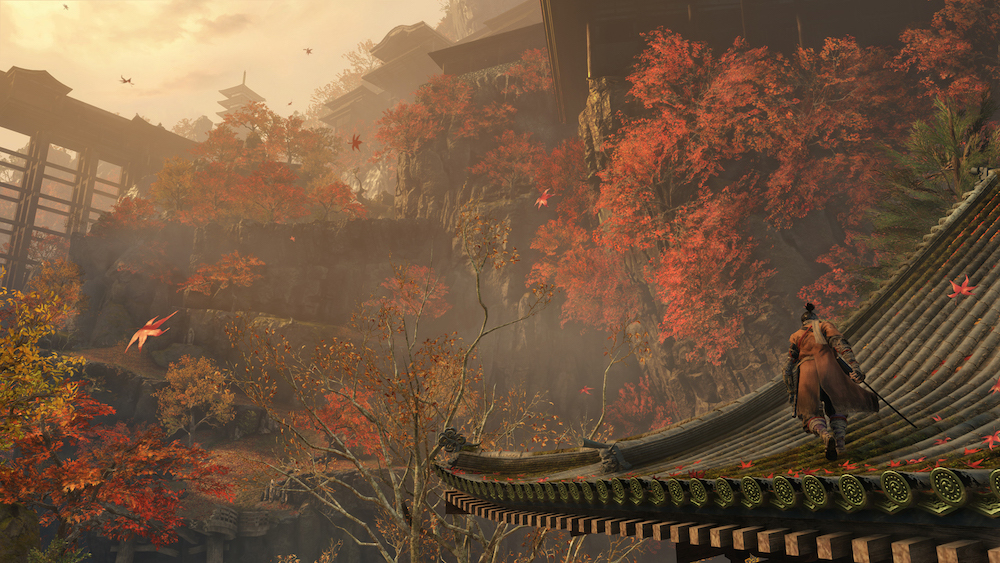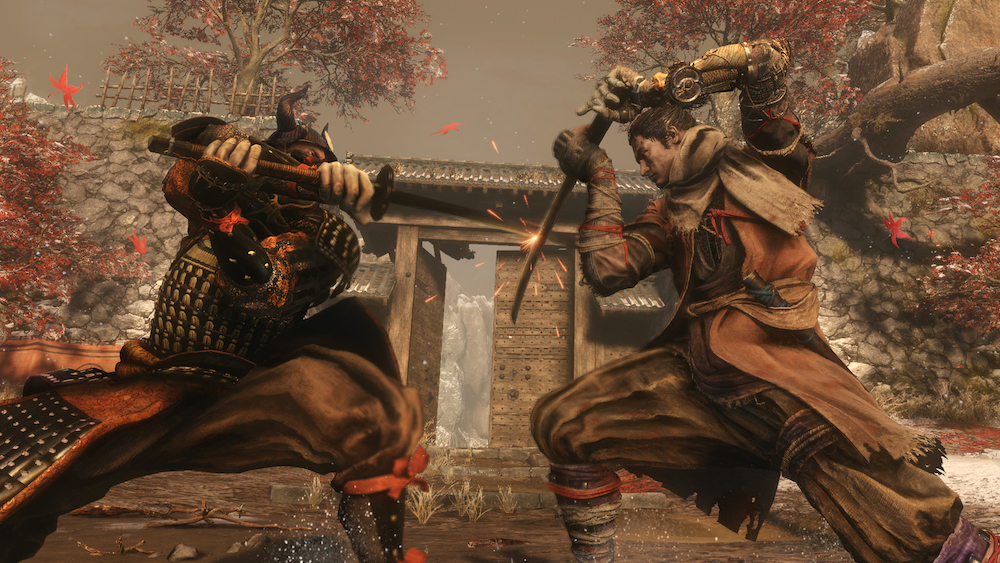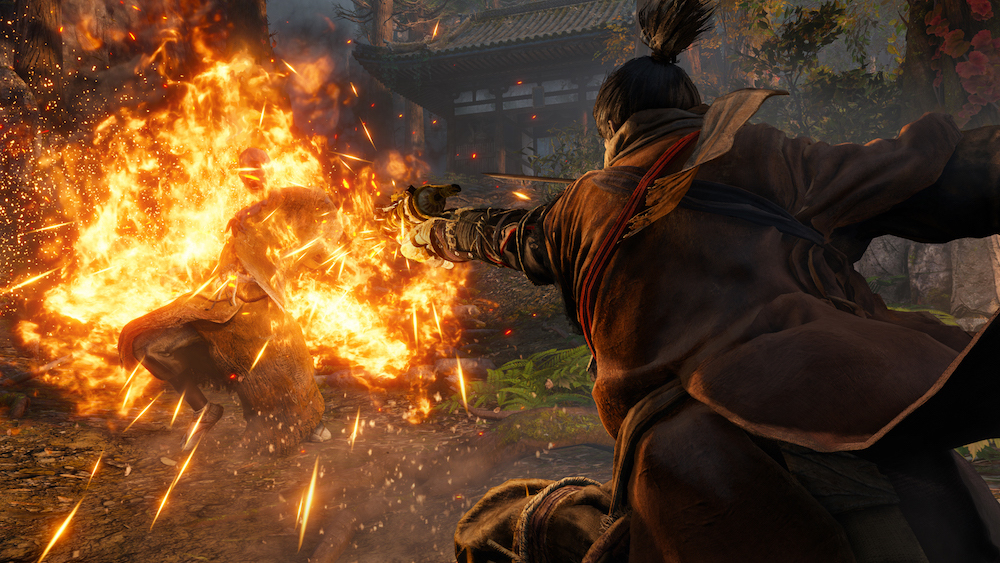The Shinobi known as the one-armed wolf, Sekiro: Shadows Die Twice's protagonist, is always at a serious disadvantage. As he passes through the hostile territory of the castle grounds where his master, the young Divine Heir, is held prisoner, he constantly faces overwhelming odds and foes as deadly as any found in developer From Software's past projects, the Dark Souls games. Combat in Sekiro is difficult and punishing--and death.
Your relationship with death as a player is central to many of From Software's games, from Demon's Souls and Dark Souls to Bloodborne. In those games, death carries a massive penalty, costing you your ability to strengthen your character, and causing every decision in combat to become one of risk versus reward. Should you fight that enemy that could kill you to gain a massive payday in power-increasing souls, or avoid the gamble? Should you press the attack for a risky win, or stay conservative and wait for a better opening but prolonging the fight inviting potential disaster?
Sekiro deals in a lot of the same sorts of situations, with enemies that are exceptionally deadly and combat that's unforgiving; you're going to die--a lot. The difference is that Sekiro handles death differently than other recent From Software games, turning it into a tool in your arsenal, while also making it even more punishing. GameSpot recently had a chance to spend a few hours playing Sekiro, which included its opening area. What was most striking was how the omnipresence of death colors the experience in a new way compared to From Software's other games, creating new strategies and new pressures. In Sekiro, death doesn't just have combat and progression consequences--it alters the game's story.

That story begins with the Wolf, essentially, dying. After an attempt to rescue the Divine Heir in a short tutorial section, the Wolf is defeated by the Heir's captor, losing an arm in the process. The Wolf awakens sometime later, having survived thanks to a strange power. Coming to in a dilapidated shrine on the castle grounds where the Heir is being held, the Wolf finds that a strange sculptor has fitted him with a prosthetic arm called the Shinobi Prosthetic. It's equipped with a grappling hook, and upgrading the arm over time is one way you'll progress your character in Sekiro. The prosthetic can be fitted with various weapons; we tried a flamethrower and an attachment that threw stunning fireworks in the faces of enemies. Other attachments include blades, and switching between your weapon options quickly makes the Shinobi Prosthetic function a bit like the trick weapons of Bloodborne.
After meeting a few other people hanging around the shrine to help out, including a nurse who won't say who her master is and a samurai who lets you practice on him because he can't seem to die, Sekiro starts to advance like any other Souls game, in which you strike out and explore the world around you. Sekiro's grapple means you can reach high areas like rooftops, from which you can scope things out and plan your route and your combat options, and you can even sneak up on enemies or descend on them from above to kill them without a fight. That's good, because fighting enemies is tough, especially when there's more than one of them; your ability to grapple out of danger, even briefly, is going to keep you alive.
Staying alive is important, but death in Sekiro is more nuanced than in Souls games. If you're killed in battle, the Wolf can use his strange power to resurrect himself. In fact, you can use death as a tool-- enemies will often wander away from you after you fall, allowing you to resurrect and sneak up behind them to deal huge blows.
The caveat is, you only get two chances to revive yourself, and after that, the consequences are dire. Like Demon's Souls, Dark Souls, and Bloodborne, you lose a huge amount of progress if you die and can't be resurrected. As you fight and kill enemies, you gain points you can use in progression trees to buy new skills and abilities for the Wolf to make him stronger; if you die, you lose half of all the points you've accumulated (but not the skills you've already acquired). The same goes for money, which is what you use to upgrade the Shinobi Prosthetic. Unplanned deaths seriously hamper your progression, and unlike the Souls games, you can't return to your own corpse to reclaim what you've lost.

What's more, death has further-reaching consequences than just slowing your ability to make yourself stronger. The more you die, the more a sickness called Dragon Rot grows in the world around you, and it can begin to afflict the people you've interacted with in the game. When a character you've met in Sekiro gets sick with the Dragon Rot, it'll change the ways they interact with you, possibly even stopping them from talking to you (or helping you, or selling you things, as the case may be). The sickness is represented by an item called Essence of Rot in your inventory, and you'll get one for each infected character. We didn't see what those characters' ultimate fates might be--Activision developers on-hand wouldn't reveal whether they could die in the name of holding back spoilers, but did say you'll be able to search for a cure to the disease to potentially the sick.
Though dying can be a huge setback in Sekiro, there is a chance you won't suffer the full pain of losing half of what you've earned every time. Sometimes when you die, a mechanic called Unseen Aid will kick in. This is basically a chance for divine intervention from the gods and Buddha, allowing you to keep all your experience points despite going to your grave. Unseen Aid has a relatively low chance of kicking in, though, and the more Essence of Rot you're carrying around, the lower the chance of receiving Unseen Aid becomes. The more you die, the tougher on you Sekiro can be.
So even with the revive system, death is a big consequence in Sekiro. Making sure you can avoid death's penalties has a big impact on how you'll play. You get two revive charges, but once you use them, each has a different requirement to restore them. One you get back from resting at one of the many idol statues in Sekiro, which are equivalent to the Souls games' bonfires, complete with the mechanic of restoring enemies you've already defeated to surrounding areas. The second charge comes from actually killing enemies--which means that you'll need to be aggressive when you return to the fight, or retreat to an idol (and respawn any defeated enemies) to protect yourself. Even if you just have the idol charge, you'll need to kill an enemy in order to be able to use it, though; you can't reclaim your own life without swapping one in return.

Despite death being an ever-present consideration, our time in Sekiro demonstrated how important being aggressive can be. Not only is it essential to make kills in order to restore your revives to deal with bad situations, but aggression baked into all of Sekiro's combat much more than in From's previous games, thanks to the Posture system. Posture refers to an enemy's ability to deal with your attacks; as you strike them or parry their blows, their Posture is lowered, and once it's completely emptied, they're staggered. That lets you get in close for a deathblow strike to do massive damage. While you can do damage with attacks when you parry a blow or break an enemy's guard, deathblows from breaking Posture and stealth attacks are the real way you win fights in Sekiro. Getting them generally requires getting right in enemies' faces, though, because Posture is both about deflecting enemy attacks and landing your own--and it's a constant balance between maintaining your own Posture and breaking your opponent's. It makes for tough, up-close fights where pressing the attack is rewarded, and the hit-and-run, conservative tactics of avoiding damage in Bloodborne and Dark Souls are much less effective.
Though Sekiro offers more combat options thanks to the addition of stealth mechanics like sneaking through bushes to ambush enemies, and the grapple that lets you zip away from enemies or onto rooftops to reposition, it definitely carries From Software's signature difficulty. The systems surrounding death and combat in the game make for a fresh take on what Souls fans are used to, but with effects that might be even more crushing than before.
What's interesting is the way Sekiro is using ideas similar to what fans are familiar with to create fresh experiences--whether it's combining the assassination opportunities of stealth that even work on some bosses, with more aggressive combat; or thinking about ways to both use and avoid death. Sekiro's different spin on From Software's formula creates a new, interesting relationship with video game death for players, while continuing to be just as crushing as fans expect.





